Types of bugs: how diverse are these insects
Bedbugs are representatives of the order of Hemoptera. Insects are ubiquitous; they live on land and in water. Numerous types of bugs are united by the presence of a piercing-sucking mouth apparatus. They have a jointed proboscis, with the help of which the absorption of plant or animal food is carried out. Most species are capable of emitting an unpleasant pungent odor that repels enemies.
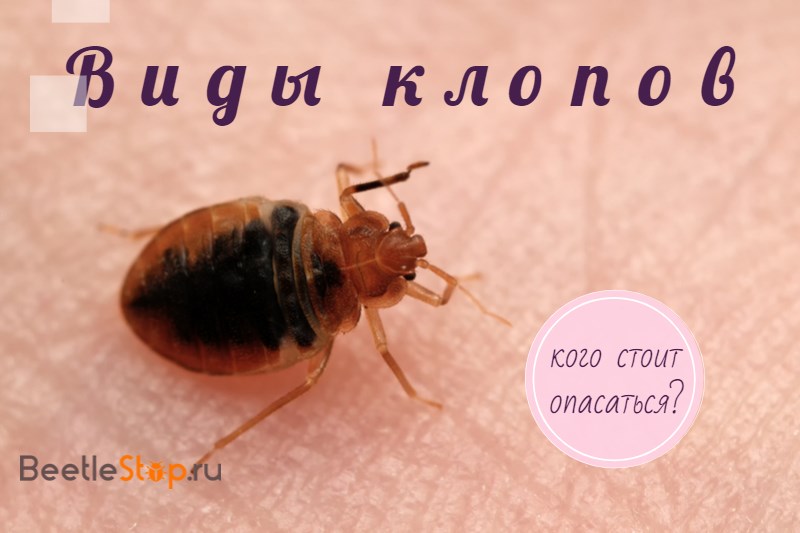
What are bugs
Representatives of the bugs suborder (Heteroptera) lead a land and aquatic lifestyle. Insects are predominantly small and medium sizes. Against their background, giant water bugs stand out, reaching a length of 15 cm. The widespread body shape is flattened, some species are close to the ball, there are rod-shaped ones. Insects share common morphological characters:
- The structure of the oral apparatus - the lower lip has changed into a proboscis, the upper and lower jaw turned into stitching bristles. The piercing-sucking type is designed for consumption of liquid food. The articulated proboscis can contract and stretch. On the chest there is a groove for its placement. Inside the body there are two channels, one food enzyme (saliva) is fed to the puncture site, and the second is pumped out liquid food.
- The presence of odorous glands - on the chest of insects there are appendages that secrete a special secret. The sharp unpleasant smell of fluid from the glands scares away potential enemies. Studying the chemical composition of a substance, scientists have established its similarity with pheromones.
- Type of wings - in the representatives of the order of the semi-rigid wing, half of the front wings are leathery or chitinous. The remaining margin and hind wings are membranous. In some species, the flying organ is completely reduced; in others, only the elytra is preserved.
- The number of limbs - all bugs have 3 pairs of legs. Their structure depends on the habitat. Water species have swimming limbs, land species have running limbs.
How many species of bugs live on our planet? Wikipedia answers this question - about 40 thousand species. They vary in size, shape, body color. Most of the insects received a protective color of grayish, brownish and greenish hues. But representatives of the superfamily Shield are yellow, blue, red. A modest coloration characteristic of vulnerable insects. Brightly colored individuals usually have strong secrets, an article about such insects "How to recognize a stink bug and get rid of a pest?".
Bed bugs have well developed sense of touch organs, in addition to antennae, sensitive hairs are present on the body. Some species are endowed with excellent vision. Their convex faceted eyes complement simple eyes.
Information. Organ reduction is associated with lifestyle features. Aquatic species do not have odorous glands, parasites have no wings.
Power Features
Varieties of bugs are classified according to the method of nutrition. Among them are:
- Herbivores or phytophages - make up the bulk of the species. Adults and nymphs feed on the cell sap of various parts of plants - leaves, fruits, seeds. Many bugs are pests of field, garden and ornamental crops.The most dangerous are quarantine species, an article will tell about one of them. "A dangerous pest of gardens and fields: how to deal with a marble bug?".
- Predators - attack invertebrates, insects and their larvae. The proboscis of bugs is shortened and strong, reminds a beak. Families of predators include: bedbug hunters, most aquatic species.
- Hematophagous parasites - insects feed on the blood of people and warm-blooded animals. Representatives of ectoparasites mainly live in houses, but some are found in natural conditions.
Information. Some species are characterized by mixed nutrition (herbivore and predation). Cannibalism is common among bedbugs.
Representatives of the laceworks and earthen shield family are able to live with ants, and individuals of the Termitaphididae family coexist with termites. Some horseflies and carnivores settle on the web, where they feed on prey caught in it.
Types of bugs with photos and names
The habitat of insects determined the features of their structure and behavior. Bed bugs are divided into 2 large groups: land and water. There are intermediate options: the water strider family lives on the surface of water bodies, and representatives of Leptopodomorpha live in the tidal zone and can be immersed in water for a long time.
Water bugs
The inhabitants of stagnant bodies of water adapted to life in the water column. They grew elongated rowing limbs for quick movement. Some individuals preferred to move slowly along the bottom, clutching at the vegetation. Almost all aquatic species are predators, depending on the size of their prey becomes caviar, fry or fish. Insects use atmospheric air for breathing. Most retained well-developed wings to help them move in search of comfortable habitats. Common types:
Water scorpion
The Nepidae family includes 230 species. The length of insects is 20-45 mm. Their forelimbs became grasping, resembling claws in structure. The abdomen ends with a breathing tube. Body color is brownish. Representatives of the family prefer to hunt from ambush, catch crustaceans, tadpoles.
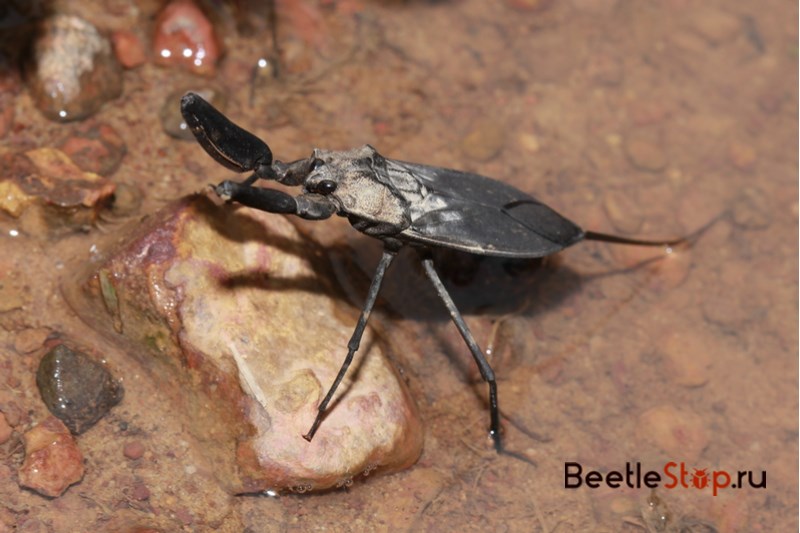
Water strider
The family of water striders (Gerridae) has 700 species. In the warm season, insects live on the surface of water bodies. The special structure of the legs, covered with non-wettable hairs, allows them to glide along the surface of the water. The front legs are short; they are used to capture prey. Adults reach 30 mm. Insects receive information using faceted eyes and sensitive limbs that capture fluid vibrations. Predators catch invertebrates that have fallen in a pond.
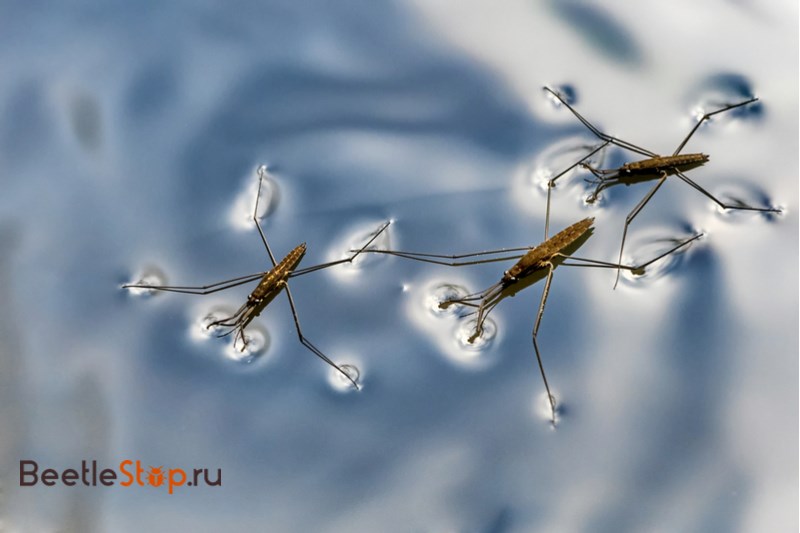
Bialystoma
A giant water bug has become a rare inhabitant of Russian reservoirs. The insect has a flat streamlined body, the forelimbs are thickened, perform an engaging function. Large (up to 15 cm) individuals attack frogs, salamanders, and fish. Adults can bite a swimmer. The male takes care of the offspring, he wears a masonry on his back until the appearance of nymphs.
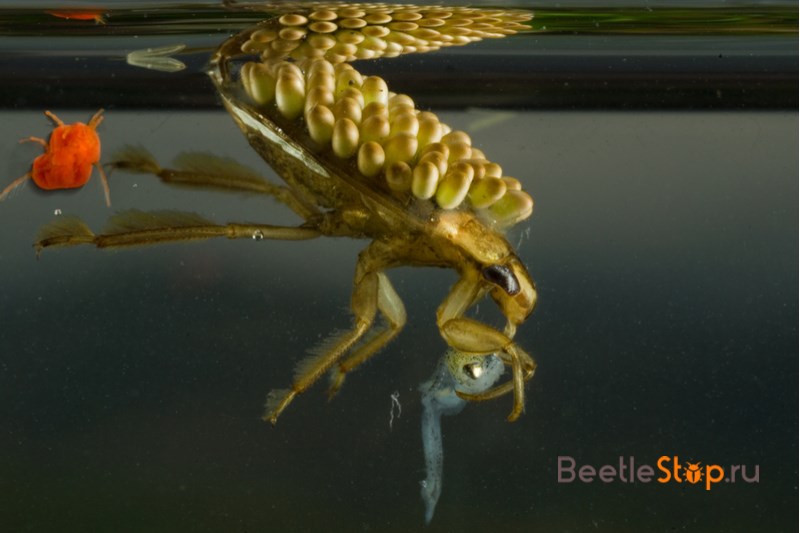
Smoothies
The genus Notonecta combines large freshwater bugs. The insects have convex elytra. Body color depends on the color of the bottom. Most of the time adults spend near the surface, holding their feet on the water film. They hibernate in forest litter and fly well. Predators feed on insects and fry of fish.
Information. Smoothies bite painfully, they were called "water wasps."
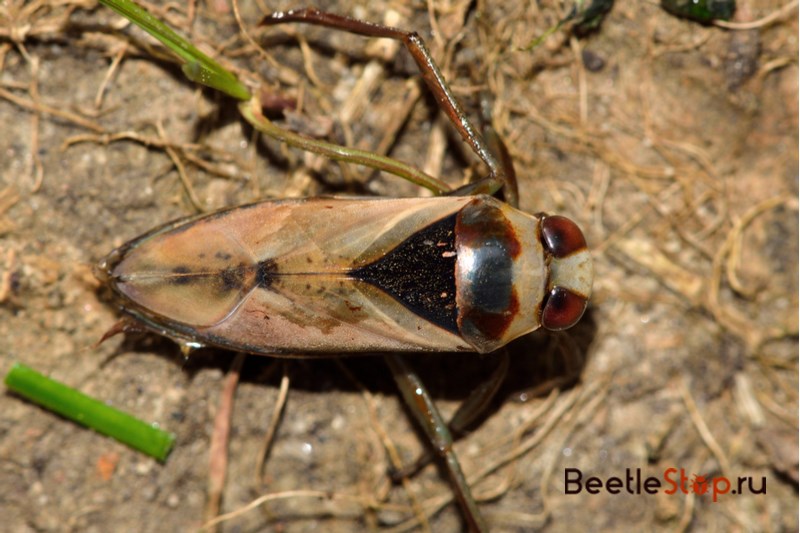
Terrestrial species
Among the insects living on land, there are inhabitants of forests, fields, deserts, the Arctic tundra, human buildings. One of the major superfamilies is the shields. The bugs were named due to the large flap on the back. This is a triangular chitin plate starting at the pronotum and covering the main part of the abdomen. The size of the flap depends on the degree of development of the wings. In a harmful turtle, the flying organ has been reduced, so the visor has developed over the entire back. The function of the chitin plate is to protect internal organs.
The largest family - true shields includes 4 thousand species.Most of them live in Europe, a little less in North America. Insects are called tree bugs, although they settle on bushes and grassy plants. Many species are agricultural pests. Representatives of the family have the same structure: the head is triangular, flattened, partially drawn into the prothorax. The eyes are convex, the antennae are articulate. Wings with longitudinal venation, developed flap. Common types:
Shield line
The insect is bright red with black longitudinal stripes called the "Italian bug." Its length is 10-11 mm, the antennae are black. Distribution area Europe and Central Asia. Phytophages feed on shrubs and trees. Prefer young shoots of aspen, mountain ash, berry bushes. Active from May to September. Larvae damage inflorescences of parsley, dill, carrots.
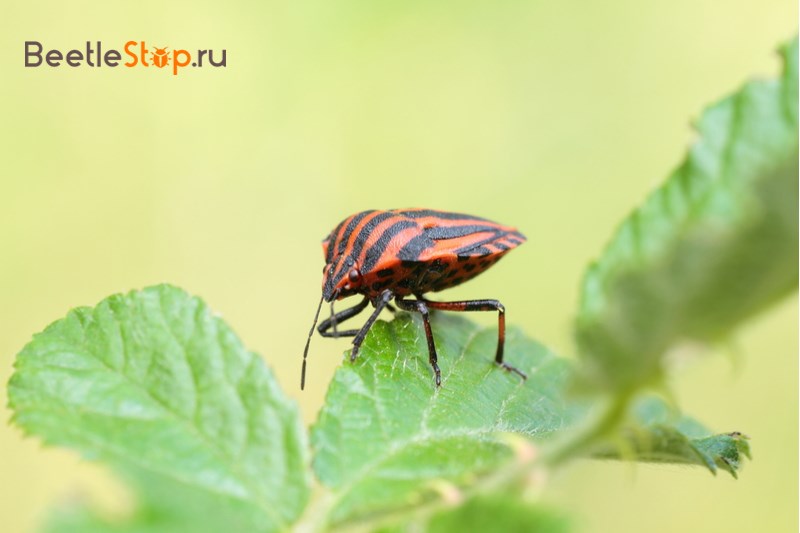
Berry shield
The species Dolycoris baccarus is a polyphage. Its representatives suck the juice of berries, ornamental, oilseeds and fruit crops. After the punctures, the buds and leaves dry. The fruits fall. The size of the pest is 12 mm. The color is reddish-brown. The body is covered with hairs. Along the abdomen, a black and white rim. Full information about the pest in the article "Berry bug".
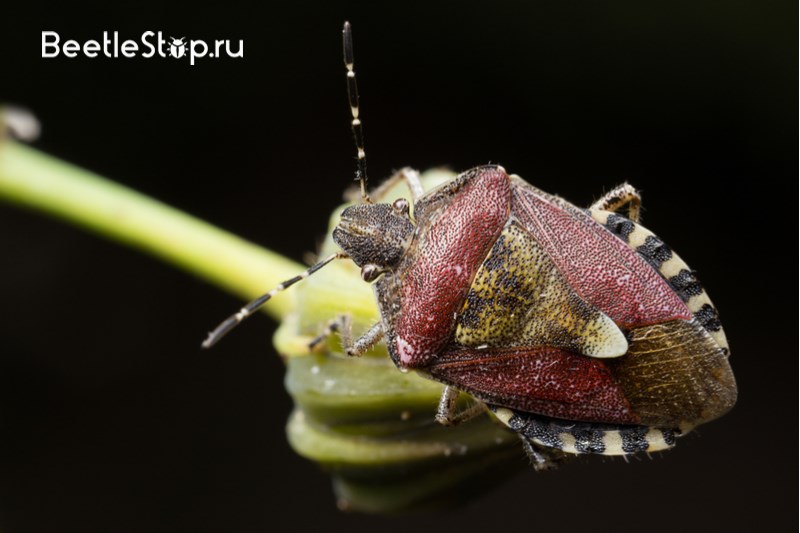
Marble bug
A dangerous pest that spoils about 300 plant species has appeared in Southeast Asia. The bug was artificially brought to the USA and Europe. In new habitats, he has no natural enemies, his number is not controlled. Insects are fertile, laying 20-30 eggs. 3 generations manage to give in a year. For the winter they climb into heated buildings. The body of the pest is pear-shaped. Coloring is brown with light dots. Length 10-17 mm.

Bugs
In Europe, the family is represented by 46 species, in North America 37 species live. Insects are small, oval in shape, the body is convex. The wings are reduced. Many species destroy cultivated plants, the most famous harmful turtle. Species Eurygaster integriceps specializes in cereals. Adult size: length 10-13 mm, width 6-7 mm. The body color is brown, the shield covers the entire abdomen. Bug bug winters in forest litter, massively flies in spring to wheat fields. Adults and larvae proboscis damage the grain. Bedbugs live in the Caucasus, in the zone of forest-steppes of Russia, in Turkey, Iran, Pakistan, Greece.

Krasnoklop
Bedbug Soldier, goats or red bug is a frequent guest of garden plots. Insects are clearly visible thanks to the red back with a black pattern. The length of the imago is 11 mm. Soldiers gather in numerous colonies from 500 to 10 thousand individuals. Bed bugs feed on fruits, seeds, plant tops, dead insects.

Predatory bugs
Several families of bugs specialize in eating other types of insects. Predators are large individuals with a black or brown color. This is the largest family of half-winged (97 thousand species). Insects have an oblong head, a filiform tendrils, an awl-shaped proboscis. They are distributed around the world. Predators are active at night.
The family of bedbug hunters is also ubiquitous. Small individuals (3-12 mm) live in gardens and meadows. They attack insects with soft integuments.

Home Bedbugs
Parasitic species of half-winged animals were chosen as the masters of man. They settled in houses, where they found favorable conditions and a constant source of food. Not everyone knows what home bugs look like. Insects have a flattened oval body. The sizes of adults are 4.5–6 mm; larvae are 1–4 mm. The color is yellowish or reddish brown. The oral apparatus consists of a proboscis and spiny bristles. Flightless insects move with the help of walking legs.
Information. After blood is drained, apartment bugs increase in size by 2 times, become red. The body takes on a spherical shape.
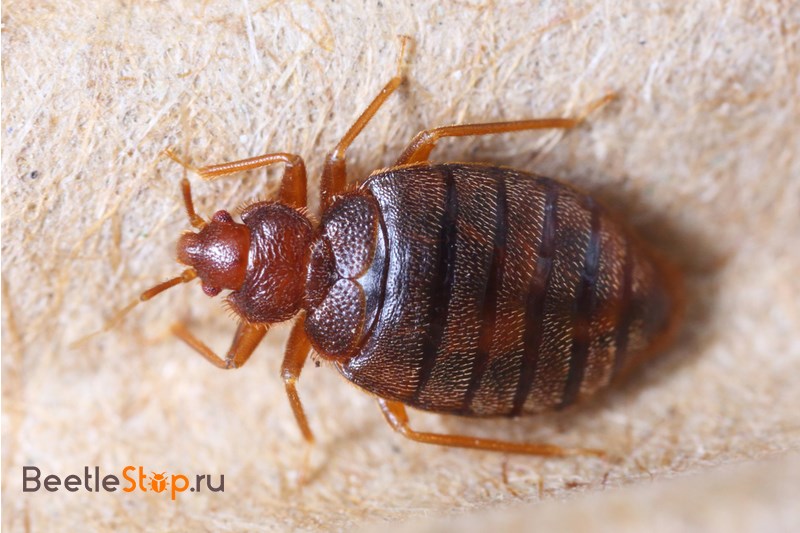
The family of bed bugs (Cimicidae) consists of more than 70 species.In total, its representatives parasitize, sucking blood from people, small mammals, birds and bats. Insect cosmopolitans spread throughout all countries. Synanthropes are active at night, when people sleep. They wait the day in the narrow crevices of the walls and furniture, into which they penetrate due to the structure of the body. Adults migrate in search of new feeding places; they can move to a neighboring apartment or building. Full details about synanthropic parasites in the article “Bed bugs: the appearance of bloodsuckers, and what harm can they do to health?”.
Types of home bugs
In Europe and Russia, 3 types of parasites were noted:
- Cimex lexctularius is the most common species. The full development cycle is completed in 30-100 days. The adults have a well-developed sense of smell; they unmistakably find a victim. They prefer to bite children because of the proximity to the skin of blood vessels. An adult parasite is able to starve for 1 year, in nymphs without nutrition, development stops. The bug emits a specific smell, which some people characterize as cognac.
- Cimex pipistrelli - representatives of the species were seen on bats in the Moscow region.
- Oeciacus hirundinis - Dove bug parasitizes on birds. Distribution area - European part of the country. After leaving the nests with swallows, insects can get into the house and eat on people. Ectoparasite bites cause severe itching and rash. Possible infection with viral and bacterial infections.
In tropical regions of Africa, South America and Asia, the species Cimex hemipterus is found. It does not differ in appearance from a bed bug, but insect saliva causes a strong allergic reaction. A blister appears at the site of the bite, burning and itching is felt.
Bed bugs are active at a temperature of 25-30 °. They feed about once a week, the nymph sucks up 0.5 ml of blood, and the imago up to 7 ml. Insects leave a whole bite path on their bodies. Injecting saliva with an anesthetic into the wound allows them to go unnoticed. Ectoparasites negatively perceive a change in climatic conditions. In frosts of -17-20 ° they live about a day, heat at 45 ° kills them in 45-50 minutes. In favorable conditions, life expectancy is 12-14 months.
Triatom bedbugs
Representatives of the family of predators live in Central America. Insects do not settle in apartment buildings; they prefer trees and animal burrows. They also live in rural areas, choosing adobe huts. Blood-sucking species are carriers of the dangerous Chagas disease. Bedbugs during a person’s bite lay off excrement infected with pathogenic microorganisms near the wound. In the process of combing, they penetrate the blood. The body of insects is pear-shaped, size 15-34 mm. Bites fall on the eyelids and lips, for this feature of the parasite is called the "kiss bug".
The variety of species provided the bugs with wide opportunities for survival. Insects adapted to life in water and on land. Pests quickly develop insecticide resistance. People have to create new chemicals and look for effective ways to deal with bedbugs.


 (votes: 4, average rating: 4,50 out of 5)
(votes: 4, average rating: 4,50 out of 5)